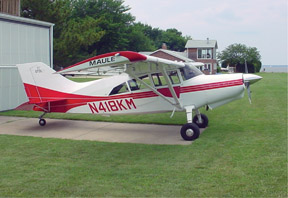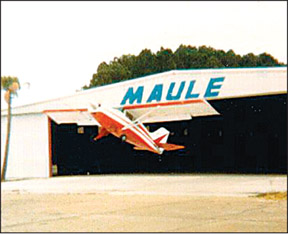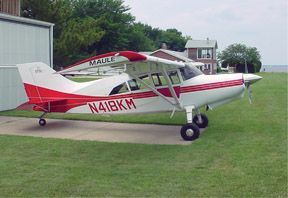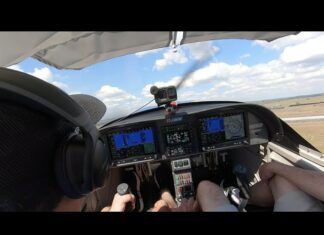The only production four-seat or side-by-side taildragger still being built in the U.S., the Maule is a one-of-a-kind airplane. Its fans can verge on the cultish.

Its easy and forgiving to fly, they say, despite its rap as a groundlooper. Its simple to fix, good at going slow yet capable of respectable cruise speeds. Baggage access is spectacular with up to four doors. The useful load is okay but don’t tell that to bush pilots who, according to legend, carry 1500 to 1800 pounds-about double the legal limit -and get away with it. There just arent any Maule accident reports in the past decade that scream “over gross.”
People do get into trouble with Maules. Some pilots do not take the time to get enough good tailwheel training, according to West Coast Maule dealer Jeremy Ainsworth and other Maule fans. He asserts that many of the Maules runway mishaps come on hard surfaces, not grass, where there is more friction to prevent them, and that many are first landings by new owners taking their airplanes home.
Model HistoryInventor B.D. Maule started coming up with airplane designs when he was in the Army assigned to a dirigible base. He formed his first airplane company in 1941 but it didnt last. The family business dates back to the 1950s, when Maule developed the basic design of the current series. A stubby-winged, round-ruddered fabric taildragger with a welded steel tube truss fuselage and a metal spar wing, it won an EAA prize at Oshkosh. Maule obtained FAA type certification in 1961, calling the airplane the Bee Dee M-4. It was powered by a 145-HP Continental O-300-A.
Mr. Maule has passed on but his company hums along after decades spent tweaking the design to create new models that arent much different from each other except for their engine options (from that first fixed-pitch Continental to 160, 180, 210, 235 and 260-HP Lycomings, a 210-HP Continental and a 220-HP Franklin) and landing gear choices (oleo struts or heavy-duty spring gear). On some models, there also have been constant-speed and fixed-pitch options and a choice between fuel injection or a carburetor. There’s a tri-gear model and even a turboprop model that has been coming out of the factory since 1984. A new one is priced at about $183,000 with standard VFR equipment. Rising like a Phoenix to join the M-7 now is the round-tailed M-4, available brand new in a 180-HP two-seat version for about $105,000, $10,000 more for a constant-speed prop.
As for the earlier models, they evolved from the first M-4 Jetasen into the M-4 Rocket, which had a 210-HP Continental, into the heavier 2300-pound Strata Rocket with a 220-HP Franklin. In 1973, the Lunar Rocket replaced it with a return to the 210-HP Continental. The Astro Rocket, meanwhile, had joined the fleet in 1970 with a 180-HP Franklin. It lasted two years but 180-HP versions reappeared as one of the M-5 variations in 1979, morphing in 1985 into both the M-6-180 and MX-7-180, which had the M-7s longer fuselage and wings and longer ailerons to maintain roll response. A 160-HP Lycoming version was offered from 1995 to 2004.
The M-5 first appeared in 1974 with either a Franklin 220-HP or Continental 210-HP as options. It had a larger tail area and the choice of 63-gallon tanks instead of 40. The demise of Franklin Engine Co. brought Continentals 235-HP O-540 into the picture in 1977. Since 1998, a 260-HP version of the Lycoming O-540 also has been offered.
The M-6 appeared in 1981 with structural changes that increased gross weight to 2500 pounds, including wings that were two feet longer than the M-5s. It offered more flap settings, up from two positions (20 and 40 degrees) to four: 24, 40 and 48 degrees and minus seven degrees for reduced drag in cruise.
M-5s were made until 1988; the last new M-6 was made in 1991. There was an M-8 briefly (1993) but the company seems to have had second thoughts about ever-rising model numbers.
Market ScanMaules are considered a bargain, even new. A long-of-tooth Cessna 180 can cost more than a newer Maule. The Bluebook puts a 1967 180 at $80,500; a 1977 M-5-235C is priced at about $46,000.
The Bluebook shows an average retail price for the earliest M-4 of $23,000. Prices range up to $39,000 for a 1973 M-4-220C. The first M-5s run from around $40,000 with the first Lycoming O-540 variant, as mentioned, about $46,000. Prices rise for various models through the mid-1980s range above $50,000 and $60,000 with the 0-540 variants the priciest. The first 180-HP models (1979-1981 M-5s) fetch $43,000 to $45,000; later versions run in the $50,000-plus range up to around $100,000 for recent editions.
M-7s run from $62,000 average retail for the oldest to $150,000 for a 2005 model, according to the Bluebook.
PerformanceThere’s a famous photo of B.D. Maule taking off out of a hangar and zooming into a steep climb within a few feet of the hangar doors. The message is this baby gets off the gravel bar and climbs away over the ridgeline like a rocket. The Maule wing does love to fly and the higher-powered models can leave the ground in somewhere around 250 feet (a couple of hundred more for the 160 and 180-HP models). At Vx with 20 degrees of flaps, they climb away at a pitch that will make a Cherokee pilot blanche. The combination of high power loading (plenty of horsepower for the weight hauled) and low wing loading (lots of wing area for the weight) do the trick.
Some years back, however, Aviation Consumer loaded up a Dakota and an M-5-235C to compare them. In cruise, with both engines firewalled, the monocoque-hulled Dakota was 5 MPH faster. It also climbed better despite book numbers that would have given the steel-tubed Maule the edge.
Readers report leaving the ground in the 235-HP version within 500 feet and climbing out at better than 1000 FPM every time. As for a 180-HP model, the Bluebooks specs give an M-5 a 900 FPM climb.
Reported cruise speeds are all over the place, from 140 to 165 MPH for the 235-HP versions. One reason, in part, is that earlier models had highly variable airspeed indications because static ports were affected by small differences in the cowling caused by manufacturing variations and wear. The ports were in the aft part of the cowling and an ice pick was the tool of choice for adjusting them by creating a lip on one side of the hole or the other to eliminate high or low readings.
Readers say 120 to 125 knots and a 12 to 13 GPH burn at cruise are typical for the 235-HP Maule at 65 percent power. That would be about 10 knots slower than a 182Q burning about the same amount of fuel. A 210-HP M-5 owner said 120 MPH (a lot of Maules have airspeed indicators marked in MPH)at 60 percent was standard.
While the two rear doors and removable rear-seat option make it easy to throw a lot of big stuff in the back, some well-equipped Maules can be left with a useful load down around 800 pounds. The legend is that the airplane easily outperforms its book load limits, however.
The low wing loading translates into low stall speeds on the Maule (33 knots for an M-5 with 40 degrees of flaps, 30 knots on an M-6 or M-7 with 48 degrees) and low takeoff and approach speeds.
That means a crosswind will be that much more of a factor than it is in a faster airplane. A slideslip to prevent drift and firm, quick rudder inputs to keep the nose straight are vital to avoiding groundloops, as they are in any taildragger. Maules with the bigger rudders are good slippers, according to some, but the Maules short-field capabilities will have to be sacrificed for a higher approach speed to maintain greater control if the crosswind component is more than a few knots.
Another issue is getting enough drag when landing to allow a steep descent over obstacles without building up speed. The post-1981 Maules with the greater range of flap settings address this concern – but watch out for the flare. Like any airplane approaching the runway steeply, slowly and with a lot of drag, timing will be critical and power may be necessary to prevent a pancake or hard landing.

Maules are considered to have lots of control power but not too much stability-a moose-chasing mans dream. Some have been annoyed, however, by a tab on the rudder that automatically deflects to counteract yaw when aileron is applied. The problem is it works we’ll at only one speed, maybe around 90 knots. At slower speeds, you’ll still need to apply rudder to keep turns coordinated. At higher speeds, too much rudder is applied automatically, which makes for “proverse yaw” or, to put it simply, a skid. “I have owned two Maules so far,” one owner wrote in reply to a chat-room request for comments. “There is not much to complain about. The only thing I would change is to get rid of that tab on the rudder. It is there for those who don’t know how to fly coordinated and is a pain in a crosswind.”
The problem is an apparent reduction in rudder power at slow speeds just when you need rudder power, say for a slipped landing.
Cabin and ComfortAccess to the two front seats is normally awkward, as can be expected in any airplane that sits at a tilt. The Maules nose pokes lower in profile than many taildraggers, however, so pilots can taxi it without S-turns to see ahead. Access to the rear seats (for up to three people in some models) and the baggage area is exceptional with big doors on each side.
The pilot sits behind the wing so lateral visibility on the inside of turns is poor. Plexiglass doors and a skylight for better views are a factory option. Maules are noisy, especially those with bigger engines. Heating is from a standard exhaust muff but the back seats in older models, especially, get cold in winter.
MaintenanceMaules are considered sturdy and reliable with few maintenance issues. The factory in Georgia, run by B.D.s widow and sons, is friendly and responsive. It buys and sells used Maules so parts are readily available. No Maule is an orphan.
Corrosion in wing lift struts prompted a 1995 AD requiring biennial inspections and treatment or replacement, if necessary. Many owners have opted for replacement. Crimping on control cable sleeves, problems with an aileron control pulley, fuel line corrosion and the rudder trim tab control were among the subjects of other ADs. A Lycoming service bulletin mandating crankshaft “retirement” by 2009 on its engines built or overhauled after March 1999 is “raising hackles,” dealer Jeremy Ainsworth wrote, because Lycoming will pay only $2000 toward a bill that could hit $7000. This is not just a Maule issue, of course.
Cracking paint on the fuselage fabric has been a complaint. So have cracking mufflers. Some tailwheels began breaking after gross weight went to 2500 pounds in 1981, a problem corrected on later models with beefier gear.
Fabric has to be inspected and eventually replaced. Its not always easy to find a shop that still does it. The factory will but one owner told us of looking for some alternative to the $27,000 price tag.
Some 79 Service Difficulty Reports pop up in a 10-year search of all Maule models. The only areas of concern that had more than one or two reports were: the muffler (5); the air-intake system (5); engine power components other than cylinders, but including the crankshaft (4); and the main gear (3).
Mods, Owner GroupVortex generators to reduce stall speed even further are a common mod to make Maules even better in the STOL department, available from Micro AeroDynamics, Inc. (www.microaero.com/ or 800-677-2370). Otherwise, the factory (www.mauleairinc.com/ or 229-985-2045) offers lots of options,, from full swing-up windows, glass doors, window and skylight, three-bladed prop for the 235 and 260-HP models, straight and amphibious floats, skis, IFR packages, autopilots and engine analyzers. Maule Mods, Inc. at www.maulemods.com/ has all sorts of Maule gadgets and mods, many aimed at sport and utility flyers.
The Web site www.maulepilots.org/ bills itself as non-profit and unconnected to any commercial operation. A regular in its chat room is “Jeremy the Maule Guru,” former bush pilot and now long-time dealer Jeremy Ainsworth, whose own strictly commercial Web site is www.maules.com/. Another site is Flymaule.org which has owner photo galleries and other tidbits, but we challenge readers to figure out who runs it and who sponsors it.
Owner FeedbackMy wife and I bought “Serenity” in November of 1999. She is a 1985 Maule M5-235 with 360 hours total since new. At the time, I had 250 hours in airplanes (10 hours tailwheel) and 30,000 hours in aviation magazines. I wanted near 182 performance and got it: 120 KTS, four people, full fuel (60 gallons with long-range tanks), decent useful load and decent range (13 GPH). We also got that fourth baggage door that will let you easily load folded bikes or a footlocker. And because of that tailwheel, I only paid $55,000.
Insurance was about $2300 the first year until I proved I could land, then back to $1400 per year (but now it has crept up to $2200 in spite of no problems). It really is easy to land. Just stay nervous and pay attention.
I put 300 hours on it the first two years flying for business. I collected a little ice twice climbing out Mountain City, Tennessee but climb rate remained good. One VFR day, I cruised briefly at 14,500 feet and Serenity was still climbing at 500 FPM when I leveled out. With just me and full fuel, I always get off in 500 feet and climb at 1000 feet per minute. That fat wing loves to fly. The Lycoming O-540 has been great. I replaced one vacuum pump, brakes and master cylinder, engine gap seals and magnetos. Annuals have been very reasonable.
The only problem has been cracking paint on the fabric, which I touch up (not hangared until recently). Still Ive been told to recover. Im trying to get that done without giving the factory $27,000.
ADs have been minimal. I reswagged the cables and sprang for new sealed wing struts rather than endure the expense of the punch test. After hundreds of my landings, the tailwheel came off during a landing on a grass strip. I ordered a new horn, reassembled, rebolted, no more problems.
The cabin is tight but comfortable. Im six feet and fit fine with a headset, but obesity is not allowed. Both front windows open and ventilation in flight is great. I added the quick release backseat for sudden loading of bike or camping supplies.
Steve Preas
Conyers, Georgia
I purchased the M-5-235C because I lived in Flagstaff at 7000 feet, where the summer temperatures often produce density altitudes of over 10,000 feet. I was not disappointed with its performance.
The M-5 would comfortably cruise at 125 knots at 2150 RPM and 21 inches and burned 12 GPH. With auxiliary tanks full (63 gallons in my plane), I planned for four hours with one-hour reserve. For a small person (five feet, six inches), comfort is moderate. The seats are a bit too upright for me and more padding was necessary. With a full-sized passenger, elbowroom is cramped.
Visibility is good for a high-wing tail dragger. The cockpit is noisy. Headsets and intercom are required. For Midwestern winter flying, the heater was only fair.
My plane had the “up gross” kit installed, increasing the gross weight from 2300 to 2500 pounds. My useful load was about 950 pounds. One could fill four seats with 170 pounders (and carry a few charts) if you just filled the main tanks (40 gallons). With full fuel, it is comfortable with two adults, two children and baggage.
The plane lived the first part of its life in Louisiana and consequently had some trouble with corrosion in the cabin area that was repaired.Though the Maule was always hangared at home, it was unfortunately stuck out in a severe hailstorm in Colorado. It cost $10,000 to recover the wings and repaint the tail surfaces and fuselage. The repair was covered by insurance but it was difficult to find anyone interested in repairing a fabric airplane locally. If I were to do it again, I would return it to the factory. Maules like mine did not have the best paint. While the rest of the plane held up well, the paint did not. Annuals ran anywhere from a low of $1200 to up to $3000 (complying with the one-time strut AD and Hartzell prop AD). Insurance ran $1800 to $2500 for $1 million.
David A Shields
Sioux Falls, SD
A few years ago, I was looking for a four-place tailwheel aircraft that could do IFR. I looked at C-180s but found that a new Maule cost just a bit more than 20-year-old IFR/GPS-capable C-180. And a Maule cost $100K less than a new C-182. So we bought a 2002 M7-235-C with a GNS-430, Stormscope and two-axis autopilot. We have flown it about 450 hours, primarily on the East Coast, in the Bahamas and the Ohio valley.
The aircraft has been terrific and trouble-free. Takeoff is in 300-400 feet with a full load and landing is about 500 to 600 feet with no braking using full flaps (48 degrees across two-thirds of the span). Cruise is 130-135 knots at 10-12,000 feet at 12.5 GPH. Full fuel is about six hours without reserves.
You can almost load your car into the baggage area with the rear-opening baggage door. With full fuel, you can really only do three adults. But that only counts if the FAA is around. I think you could probably load the airplane full of bricks and it would still take off in less than 500 feet at sea level.
It is quite a performer. After takeoff, I climb at Vx to 500 feet and the angle of climb is impressive. I got the O-540-B4B5 engine, which is a carbureted version that can use 80 octane. I didnt want to pay extra for the fuel injection and be a slave to 100 octane fuel. I didnt get the three-blade prop or the vortex generators since they cut cruise speed – and I didnt need better landing or takeoff performance. I am on the Lycoming crankshaft list but that is no fault of Maule.
Although I love the airplane, it requires total attention on landing, particularly in gusty crosswinds: zero crab and zero drift until you are at taxi speed. Crosswind landings are done no flap, which completely changes the character of the approach. Now you use 1500 feet of runway without braking, which really isn’t bad compared to other aircraft. The aircraft is very short-coupled so it is sensitive in pitch and yaw on landing. I did one groundloop due to inattention; it was cheap lesson since both main wheels stayed on the ground.
I had a few minor problems with the aircraft after I picked it up from the factory but a trip to Moultrie on the way to Sun n Fun fixed them all in a few hours and the Maule family lent us their car while they did the aircraft. Annuals are about $1000. Hull and $1 million insurance are about $3500.
Earlier Maules had problems with paint but that is not the case with my aircraft. I hangar it and the paint has been no difficulty.
So if you are looking for 95 percent of a C-182 at 60 percent of the price, look at Maules. They are great performers at a reasonable price.
Vince Massimini
Kentmorr Airpark, Maryland
In 1999, I bought a Maule 7-235 taildragger brand new from the factory. It has been a great airplane and it has taught me more about flying than I have learned from instructors.
The Maule Company certainly is right in all it touts about this being an incredible load-carrying STOL aircraft in tailwheel configuration but you must first learn how to handle it. I recommend Maule instruction from someone who has 500 hours of bush experience.

252
This plane can easily lift 1800 pounds of people, fuel and baggage and has a climb rate of 400 FPM on a standard day. The problem is lack of room and the FAA certification only allows 870 pounds. At the FAA max weight on a standard day, you could easily expect 1200 FPM. If you fly this five-seat Maule loaded like a Super Cub – two people and half fuel, expect 2000 FPM from a good pilot on a standard day. I emphasize pilot training is everything on this airplane.
I have the spring gear and it is super heavy duty, as is the tailwheel. This machine is rugged, easy to maintain and repair. Parts are readily available and a lot are marked NAPA auto parts from the factory.
In 2002, I put the Maule on Wip 3000 floats and easily lost 25 knots of cruise. I lost only 100 lbs. of certified carrying weight. This plane truly lacks the power as an amphibian. When temperatures reach 95 degrees F, this airplane is useless. The Wip 3000 is just too big for the 235-HP Maule.
Matthew J. Clemente
Troy, New York
I have owned three Maules in the last three years, one tricycle model and two taildraggers with the Lycoming 540. I purchased them new and owned each a couple of years then sold and moved to the next one. They are easy to sell and hold their value well.
Here is what I like about them: 1) Very safe airplane, built around a steel tube frame which becomes a roll cage in the event of an accident; 2) few if any ADs on the airframe of newer models; 3) inexpensive to annual, mine average $650; 4) use Lycoming engines, durable with high TBO; 5) replacement parts from Maule are very reasonable; 6) easy access to the baggage area with huge double doors; 7) nice “light IFR” machine; 8) all-metal wings; 9) compared to any other new airplane, they offer huge value and performance for the dollar; 10) the standard-equipped plane from the factory has all the equipment for VFR flight; 11) the wide aluminum main gear taildragger is exceptionally stable on the ground and can haul a big load; 12) the observer options give you amazing visibility both up and out with complete glass doors and huge skylight; 13) they have large fuel capacity with extended tanks, in the range of 82 gallons useable; 14) they are “chick magnets” (my wife would kill me if she knew I sent this photo). Anyway, slapping some Alaska bush wheels on and this plane can get you to the gravel bars for great picnics!
What I don’t like about the Maule: 1) the vertical stabilizer could be redesigned to be more aesthetically pleasing. The large dorsal fin makes the plane look stubby; 2) one inch more of rear travel in the front seats would make all the difference for me (Im six-foot-three); 3) the ELT should be remotely mounted using the latest ELTs.
The current one is loosely mounted on the side of the interior so access can be gained to the on-off switch. Its a lousy setup, in my view, and it needs to be mounted securely in the rear fuselage with an activation switch in the panel; 4) pilots transitioning to the taildragger Maules do not get adequate training, consequently groundlooping it, which gives the aircraft a bum rap as difficult to land. Thats simply not true. Its lack of training.
Scott Gustafson
Portland, Oregon


